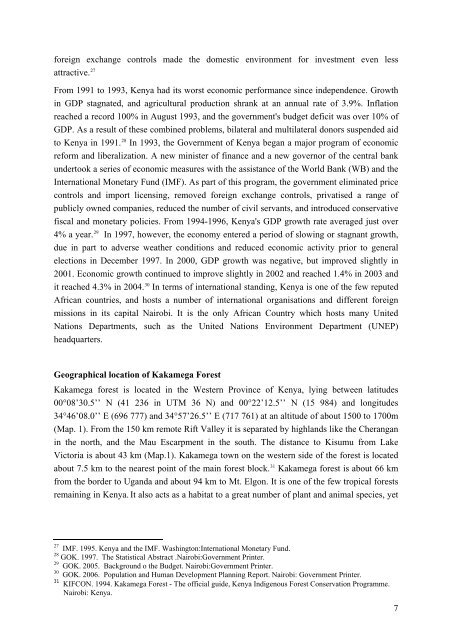THE UNIVERSITY OF LEIPZIG
THE UNIVERSITY OF LEIPZIG
THE UNIVERSITY OF LEIPZIG
You also want an ePaper? Increase the reach of your titles
YUMPU automatically turns print PDFs into web optimized ePapers that Google loves.
foreign exchange controls made the domestic environment for investment even less<br />
attractive. 27<br />
From 1991 to 1993, Kenya had its worst economic performance since independence. Growth<br />
in GDP stagnated, and agricultural production shrank at an annual rate of 3.9%. Inflation<br />
reached a record 100% in August 1993, and the government's budget deficit was over 10% of<br />
GDP. As a result of these combined problems, bilateral and multilateral donors suspended aid<br />
to Kenya in 1991. 28 In 1993, the Government of Kenya began a major program of economic<br />
reform and liberalization. A new minister of finance and a new governor of the central bank<br />
undertook a series of economic measures with the assistance of the World Bank (WB) and the<br />
International Monetary Fund (IMF). As part of this program, the government eliminated price<br />
controls and import licensing, removed foreign exchange controls, privatised a range of<br />
publicly owned companies, reduced the number of civil servants, and introduced conservative<br />
fiscal and monetary policies. From 1994-1996, Kenya's GDP growth rate averaged just over<br />
4% a year. 29 In 1997, however, the economy entered a period of slowing or stagnant growth,<br />
due in part to adverse weather conditions and reduced economic activity prior to general<br />
elections in December 1997. In 2000, GDP growth was negative, but improved slightly in<br />
2001. Economic growth continued to improve slightly in 2002 and reached 1.4% in 2003 and<br />
it reached 4.3% in 2004. 30 In terms of international standing, Kenya is one of the few reputed<br />
African countries, and hosts a number of international organisations and different foreign<br />
missions in its capital Nairobi. It is the only African Country which hosts many United<br />
Nations Departments, such as the United Nations Environment Department (UNEP)<br />
headquarters.<br />
Geographical location of Kakamega Forest<br />
Kakamega forest is located in the Western Province of Kenya, lying between latitudes<br />
00°08’30.5’’ N (41 236 in UTM 36 N) and 00°22’12.5’’ N (15 984) and longitudes<br />
34°46’08.0’’ E (696 777) and 34°57’26.5’’ E (717 761) at an altitude of about 1500 to 1700m<br />
(Map. 1). From the 150 km remote Rift Valley it is separated by highlands like the Cherangan<br />
in the north, and the Mau Escarpment in the south. The distance to Kisumu from Lake<br />
Victoria is about 43 km (Map.1). Kakamega town on the western side of the forest is located<br />
about 7.5 km to the nearest point of the main forest block. 31 Kakamega forest is about 66 km<br />
from the border to Uganda and about 94 km to Mt. Elgon. It is one of the few tropical forests<br />
remaining in Kenya. It also acts as a habitat to a great number of plant and animal species, yet<br />
27 IMF. 1995. Kenya and the IMF. Washington:International Monetary Fund.<br />
28 GOK. 1997. The Statistical Abstract .Nairobi:Government Printer.<br />
29 GOK. 2005. Background o the Budget. Nairobi:Government Printer.<br />
30 GOK. 2006. Population and Human Development Planning Report. Nairobi: Government Printer.<br />
31 KIFCON. 1994. Kakamega Forest - The official guide, Kenya Indigenous Forest Conservation Programme.<br />
Nairobi: Kenya.<br />
7






